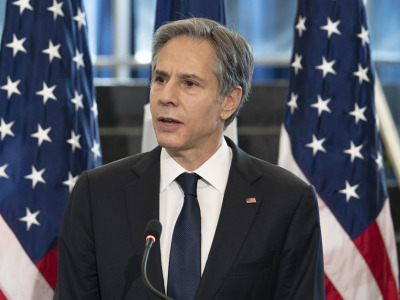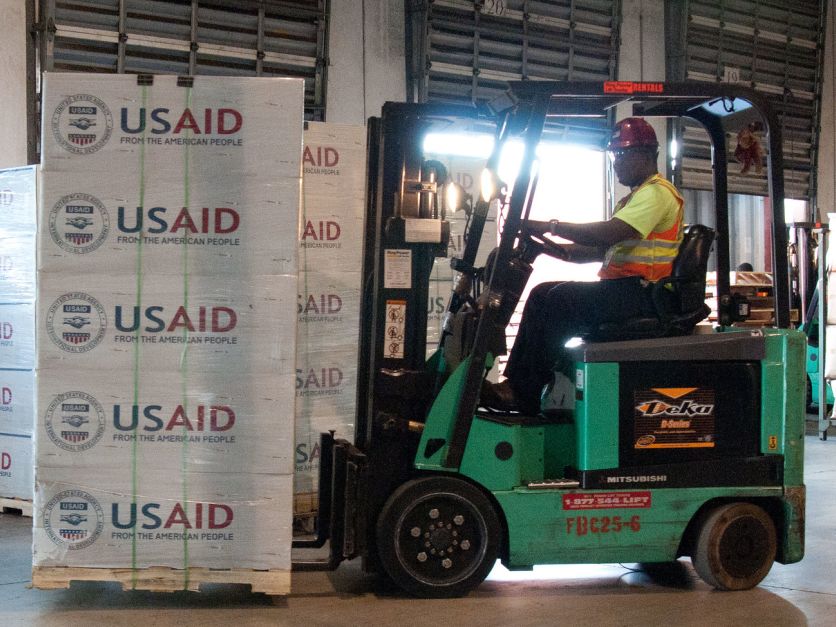The U.S. is donating billions of dollars worth of food and other humanitarian assistance to address the global food crisis, but some of the poorest regions in the world still stand on the precipice of famine.
Nearly 200 million people in 53 countries are in what the United Nations Food and Agriculture Organization calls the third, or “crisis,” phase of hunger, according to U.S. Agency for International Development Administrator Samantha Power.
It’s a dire classification in which hunger “prevails so intensely that lives and livelihoods are at risk,” Power said at an event sponsored by the Center for Strategic and International Development. She quickly added that “things are going to get worse.”
Climate crises around the globe — from record heat waves in Europe to extended drought in Africa, together with the Russian invasion of Ukraine that cut off supplies of millions of tons of wheat, corn and vegetable oil — are already adding tens of millions to the “crisis” classification, say officials at the World Food Program, USAID, FAO and other organizations.
What’s worse, stressed Power, is there are signs that regions are being pushed into the fourth “emergency” phase and beyond.
The fifth and final stage of the internationally recognized Integrated Food Security Phase Classification system is “catastrophe,” said Power.
 USAID Administrator Samantha Power
USAID Administrator Samantha Power“There’s a word for when catastrophic hunger is widespread: and that word is famine,” she said. “The UN secretary-general has said multiple famines may be declared this year and 2023 may be even worse … Today, we are in a global food crisis. What can we do together to avert a global food catastrophe?”
A clear indication that global hunger is worsening is the severest form of malnutrition, called wasting, and there are already millions of children fading because they have no food.
“Their bodies beginning to consume themselves on what little stores of energy they have left. Many growing so weak that they are unable to eat food that is put in front of them,” Power said.
William Moore, CEO of the Eleanor Crook Foundation, said he was in South Sudan less than two weeks ago and the sight of wasting children left him devastated.
“Severe wasting is a state of multiple organ failures, loss of brain mass, loss of vision,” he said. “Your hair becomes brittle and your skin starts to peel … You become exhausted, eventually unable to move.”
The dire situation is made worse by the fact that these children cannot simply be provided traditional food. Moore, Power and others like UNICEF Director Catherine Russell are promoting a portable, heat-resistant treatment called ready-to-use therapeutic food (RUTF), tiny packets containing milk powder, vegetable oil, peanuts, sugar and micronutrients that can be administered in homes.
Power announced Monday that the U.S. will donate $200 million to UNICEF to buy and distribute RUTF to countries in the Horn of Africa. Similarly, the Eleanor Crook Foundation, together with the Center for Strategic and International Development and others, will be contributing $50 million.
But the world is past the point of treating hunger with food donations alone, said Power.
Ukraine needs to be free to ship its grain, Russia needs to stop constricting its fertilizer exports and African farmers need to be able to farm better and increase production, she said.
Negotiators from Ukraine, Russia, Turkey and the United Nations are expected to meet again this week in efforts to allow a Black Sea corridor for Ukraine to export its wheat and corn through its primary ports in Odesa and Mykolaiv and the stakes are extremely high.
Before the war, African and Middle East nations were dependent on Ukrainian grain imports. Now, after years of drought and spiraling agricultural production, the people need those imports more than ever, but they remain mostly cut off by a Russian blockade.
“Since the war began, the Russian military has destroyed and mined Ukrainian farmland, bombed agricultural storage and processing facilities, and effectively blockaded Ukraine’s Black Sea ports, leaving 20 million tons of corn and wheat locked in silos and shipyards,” Power said. “Trillions of calories are literally sitting in storage while people go without food. With storage facilities still full, this year’s summer harvests an expected 50 million tons of grain sowed by courageous Ukrainian farmers wearing flak jackets and wielding demining equipment those tons of grain have nowhere to be stockpiled.”
Don’t miss a beat! It’s easy to sign up for a FREE month of Agri-Pulse news! For the latest on what’s happening in Washington, D.C. and around the country in agriculture, just click here.
Perhaps just as disastrous to hunger levels in Africa as the blockade on Ukraine’s grain shipments is Russia’s restrictions on fertilizer exports, said Power. Secretary of State Antony Blinken has called the restrictions a weapon of war and Power said it’s a potent one.
 Secretary of State Anthony Blinken
Secretary of State Anthony Blinken“Russia is the world’s largest exporter of fertilizer, but starting in November last year, Russia began to restrict some of its supply to global markets, contributing to a near tripling of fertilizer prices over the past year,” she said. “With higher fertilizer prices, farmers can only afford to buy less fertilizer, meaning that they plant less, meaning smaller harvests and smaller future incomes. Farmers in Africa, especially, will be forced to cut back on fertilizer at the worst possible time, leading to a predicted shortfall in their harvests of 20 percent worth some $11 billion.”
Norwegian fertilizer giant Yara International earlier this year donated 40,000 metric tons of fertilizer to African nations, and Power announced Wednesday that the company has agreed to donate 20,000 tons more, which USAID will help distribute to 100,000 farmers.
And the U.S. is assisting countries like Ethiopia by using satellites to help farmers maximize the impact of the fertilizer they have. Power said farmers there were able to reduce fertilizer waste by up to 80% while also increasing yields. Now, the U.S. is doing the same for farmers in Niger, Ghana, Tanzania, Malawi and Zambia.
But the situation is still dire, especially in the Horn of Africa where farmers could be facing their fourth consecutive drought during a historically rainy season.
“To date, at least seven million livestock have already died in Ethiopia, Kenya, and Somalia,” Power said. “There just isn’t enough water to quench their thirst or enough grass to feed them.”
Power announced Monday an increase in U.S. emergency funding by $1.2 billion for “the immediate needs faced by the people of Somalia, Kenya, and Ethiopia." She stressed that “hunger cannot be fought with food alone” and the global community needs to invest more heavily in long-term solutions like the U.S. efforts to improve fertilizer usage.
Global investments in improving long-term agricultural production in Africa reached an average of $20 billion per year in the 1980s, Power said, but by 2006 that had dropped to just $5 billion. The problem with that trend, she said, is “that while humanitarian aid saves lives, it doesn’t generally leave countries … better able to weather the next failed harvest.”
Still, Power, Russell and Moore all stressed the need for lifesaving humanitarian donations.
Members of the delegation that visited wasting children at feeding centers in South Sudan earlier this month were boarding a United Nations cargo plane to head home when, according to Moore, he heard someone on the trip near him say, “I don’t understand how there could be a God on this earth with suffering like that.”
For more news, go to www.Agri-Pulse.com.


